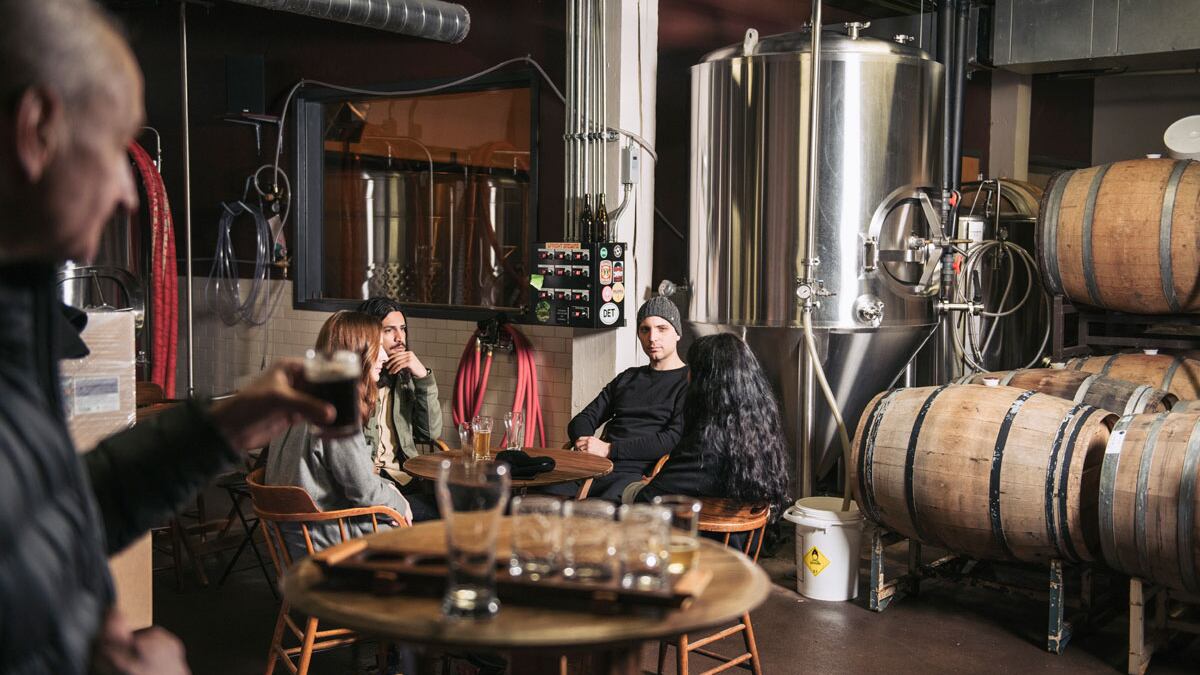The greatest success Upright Brewer Alex Ganum had last year was also his biggest failure.
In September, Ganum found himself dumping four barrels of some of the most painstakingly crafted beer he makes down the drain at his tiny, subterranean brewery in the Leftbank building.
"It's probably the most expensive beer I've ever dumped," he says.
That beer, Oregon Native, was a wine-beer hybrid like almost no other in the world. Each barrel of ale is stuffed with 100 pounds of pinot noir grapes from famed Patton Valley Vineyard in Gaston and fermented with yeast growing on the grapes. It then matures for 12 months in red-wine barrels.
But when Ganum tasted the batch he made from the 2015 harvest, he got the vinegar tang of acetobacter, a bacteria that will only increase its effect with time, turning the beer undrinkable.
"Some barrels had it more than others, so I thought I could even it out by blending them together," Ganum says. "I was wrong."

Unwilling to release a beer that didn't meet his standards, Ganum drained the whole batch.
That's a mighty shame. Because the Oregon Native released last year, with grapes from the 2014 harvest, was the first beer we've tried that ever truly expressed the beautiful flavors of skin-on wine grape amid the light hop bite and aromatics of beer—a farmhouse flavor deep as any Belgian, with a nose that brings you right back to the grape crush at harvest.
"I've had wine beers before," says Ganum, "But the flavor didn't come really through except as a light bit of sugar. Maybe the flavor of the beer was too intense. It can be hard to get a lot of the flavor of the fruit. We wanted to make something a little more tame, wanted to keep the integrity of the flavor."
It's an extraordinary beer—we've had wine beers before, none of which managed to land the proverbial triple axel—and one Ganum feels has only gotten better in the bottle since its May 2016 release.
However refined it now tastes, it began with a what-the-hey shrug and a flatbed truck.
Imbue Vermouth's Derek Einberger, also the chief winemaker at Patton Valley Vineyard, had been pestering Ganum for months about making a beer together with Einberger's vineyards' vaunted fruit. At harvest, amid many-million-dollar acres, Ganum rolled up to the vineyard in a rented truck.
"I don't know why we did it this way," says Ganum. "[Upright brewer] Bobby and I rented a little Penske truck with the barrels from Upright and popped all the heads out of them. Harvest is going on, it's super hectic, and people are everywhere. We put the barrels under the destemmer, under the sorting line, and let the grapes pour right into the barrels."
The yeast they pitched belongs in no brewery; it came from the vineyard.
"I wanted to do something that didn't have any brewer's yeast at all. We wanted the flavor of the pinot noir to come through," says Ganum. "It's just some orchard culture ramped up with some grape juice. It was an active yeast, basically fermented wine. We dumped in whatever amount of orchard yeast we thought was appropriate, just sighted it out, bunged them up, got the barrels back together—it was really kind of a pain in the ass—and came back to the brewery. The wort went right on top."

Ganum eventually mixed in a pale-malt beer made with three-year-aged hops. The mild beer was meant to allow the wine grapes to impart their own flavor over the extended maturation process. But he kept initial fermentation slow, to keep the beer from thinning out.
"I don't know if you've had these barrel-aged beers where it tastes great, it smells great, and it's just thin," Ganum says. "[Brewers] want ultimate dryness. We've never strived for that. There's a lot to be said for residual sugar, to help balance the body, help balance the flavor. The beers that are really bone dry, I don't think they satisfy on the same level. To put it simply, they don't feel as good."
Oregon Native feels very, very good. The wild-fermented ale is just lightly sweet, with an aching fullness and rewarding complexity that speaks to the ancient lambics of Belgium much more than America's proliferation of one-note, acidic, nouveau sours. It tastes somehow like both beer and natural wine at once, a merger of Oregon's two great fermenting traditions in a way that does justice to both.
And the best part? Though you won't see another vintage till 2018, last year's batch is still hanging around at a few stores as this guide releases, and it's been matured to its sweet spot. Open immediately, and enjoy profusely.

Welcome to the 2017 Portland Beer Guide
This Year's Guide Is Dedicated to Dean Pottle
An Oral History of the Horse Brass
The Best Portland Bars for Hardcore Bar Geeks | Portland's Best Cider Bars | These Are the Bars in Portland Where We Get Our Beer to Go | Where to Get Crowlers in Portland | Big Beer Halls Where You Can Drink With Half of Portland | The Six Best Spots to Take Little Ones For a Little Nip | Warm & Cozy Beer Caves | Portland Spots Where Great Food and Beer Come Together | Tap a Belgian or German at These Portland Bars

